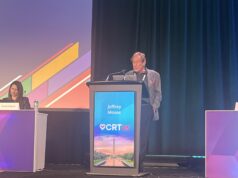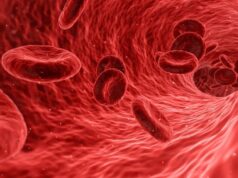
The RE-DUAL PCI trial indicates that dual therapy with the non-vitamin K antagonist oral anticoagulant dabigatran (Pradaxa, Boehringer Ingelheim)—and not aspirin—and a P2Y12 inhibitor is associated with a significant reduction in major bleeding, compared with conventional triple therapy, in patients with atrial fibrillation who have undergone percutaneous coronary intervention (PCI). A previous trial, PIONEER AF-PCI, reported similar findings with another non-vitamin K antagonist oral anticoagulant (rivaroxaban, Xarelto, Bayer).
Writing in The New England Journal of Medicine, Christopher Cannon (Baim Institute for Clinical Research, Boston, USA) and others report that recent studies have indicated that conventional triple therapy—aspirin, a P2Y12 inhibitor, and warfarin—following PCI in patients with atrial fibrillation is associated with high rates of major bleeding and these findings have “prompted efforts to seek new therapeutic strategies”. They add that one such approach is to use a non-vitamin K antagonist oral anticoagulant, rather than warfarin, in this setting while another is to drop aspirin from triple therapy (so that therapy consists of a P2Y12 inhibitor and an oral anticoagulant).
Cannon told Cardiovascular News that non-vitamin K antagonist oral anticoagulants, for patients with atrial fibrillation in general, “are easier to use” than warfarin (no INR monitoring) and are associated with much less intracranial bleeding. He notes: “They are almost always used for non-valvular atrial fibrillation in new patients.”
The aim of the RE-DUAL PCI (randomised evaluation of dual antithrombotic with dabigatran vs. triple therapy in patients with non-valvular atrial fibrillation undergoing percutaneous coronary intervention) trial was to evaluate the aforementioned dual therapy of a P2Y12 inhibitor and an oral anticoagulation using a non-vitamin K antagonist oral anticoagulant. Cannon reports that he and his fellow investigators wanted “to see if the dual therapy approach would be better in terms of safety but still OK regarding thromboembolic events”.
Overall, 2,725 patients with atrial fibrillation who had undergone PCI were randomised to receive conventional triple therapy (981 patients), dual therapy with 110mg of dabigatran (981), or to dual therapy with 150mg of dabigatran (763). In the USA, older patients are not eligible for the 150mg dose; therefore, the number of patients in the 150mg dual therapy group was lower than that of the 110mg dual therapy and triple therapy groups.
The primary endpoint was significantly lower in the 110mg dual therapy group compared with the triple therapy group (15.4% vs. 26.9% vs. respectively; p<0.001 for superiority). The difference between the 150mg dual therapy group and the triple therapy group was also significant (20.2% vs. 25.7%, respectively; HR = 0.72, p = 0.02). In addition, when major bleeding events—defined by Thrombolysis in Myocardial Infarction (TIMI) criteria—were assessed, both dabigatran groups were associated with significantly lower rates than were the triple therapy group: 1.4% for 110mg vs. 3.8% for triple therapy (p=0.002) and 2.1% for 150mg vs. 3.9% for triple therapy (p=0.03).
There were no significant differences between the dabigatran groups (either combined or individually) and the triple therapy group regarding the incidence of the composite efficacy endpoints: 13.7% (both groups combined) vs. 13.4% for triple therapy; p=0.005 for non-inferiority). Cannon says that the “key thing” about this trial is that it shows that both doses are “full-dose anticoagulation”. He adds that both of these doses have already been shown in the prior RE-LY trial to provide protection against the risk of stroke.
The results of RE-DUAL PCI are in line with (and actually exceed on major bleeding benefit) those of PIONEER AF-PCI, which showed that two regimens using low-dose rivaroxaban—15mg once daily plus a P2Y12 inhibitor or 2.5mg twice daily plus a P2Y12 inhibitor and aspirin—were associated were significantly lower rates of clinically significant bleeding than was conventional triple therapy in atrial fibrillation patients who had undergone PCI.
According to Cannon, ongoing studies are exploring the use of other non-vitamin K antagonist oral anticoagulants in atrial fibrillation/PCI patients. He comments that the study that is reviewing the drug apixaban (Eliquis, Bristol-Myers Squibb/Pfizer) has a “two by two factorial design”. He explains: “It is reviewing how much of the reduction in bleeding benefit with a dual therapy approach is contributed by the removal of aspirin—which likely to be the dominant part of the benefit—and how much is contributed by the non-vitamin K antagonist oral anticoagulant. There were certainly be some benefit with the non-vitamin K antagonist oral anticoagulant, since we saw differences with doses in RE-DUAL PCI. There was also a very low rate of intracranial haemorrhage in the dabigatran groups.”
The RE-DUAL PCI trial was presented, by Cannon, at the European Society of Cardiology (ESC) congress (26–30 August, Barcelona, Spain), coinciding with its publication in The New England Journal of Medicine.










